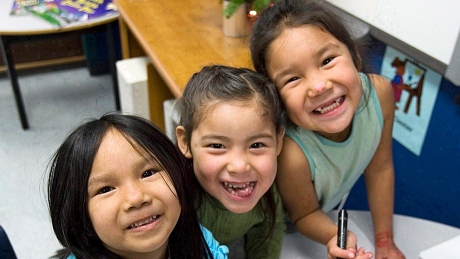4.2.1 History of Indigenous Education

Having an education is an important determinant of child and youth health – and in fact, it influences health and well-being throughout life. Achieving an education is also linked to other determinants of health – it leads to employment and income security. This provides children, youth and families with a greater sense of control over their life circumstances and improved mental health and well-being. Education also brings positive outcomes to communities including economic development and growth, enhanced innovation and social cohesion, reduced reliance on social assistance, and positive intergenerational effects. 1
Before colonization, Indigenous peoples had their own system of education that was rooted in the community and the natural environment, and situated within a spiritual worldview.1 Knowledge of ancestors was highly valued and was passed through the generations experientially and through oral traditions. Education was intended to provide children and youth with the skills and knowledge they needed to ensure they, their families and their communities survived.1,2
After Europeans came to Canada, Indigenous communities were forced to have formal education systems, based on the values of the settlers. These were dominated by churches and governments. Most notably, the Indian Residential School (IRS) system was forced on Indigenous children and families. This system undermined the traditional education of Indigenous children, removed them from their families, and exposed them to physical, mental and sexual abuse. It resulted in the mass loss of culture and language along with generations of negative physical and mental health outcomes. The IRS system played a definitive role in contributing to the current state of education among Indigenous peoples today.1,2 The Standing Senate Committee on Aboriginal Peoples reported that the Indian Residential Schools had a devastating effect on generations of Indigenous people. They identified the many ways that this happened. The negative effects of Residential schools have impacted successive generations of Indigenous people.1 They removed children from families and communities. They denigrated their culture and identity. The schools subjected them to physical and sexual abuse. The result was that many Indigenous people were left with reduced self-worth and self-determination, marginalization and intergenerational trauma.1,2
While the Residential Schools have closed, and assimilation is no longer directly forced on Indigenous children and youth, the formal education system continues to be based on Eurocentric knowledge and values, thus perpetuating the values of colonialism rather than Indigenous values. This can further marginalize Indigenous students.1
1Standing Senate Committee on Aboriginal Peoples. (2011). Reforming First Nations education: From crisis to hope – accessed November 23, 2018.
2First Nations Child & Family Caring Society of Canada. (2013). Information Sheet #2: First Nations Education, p.3.
